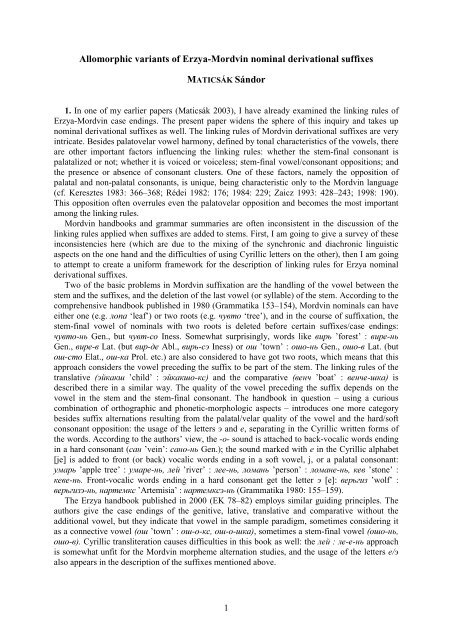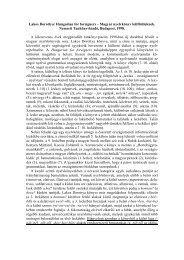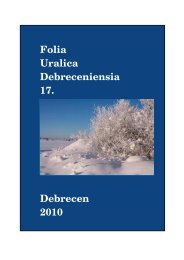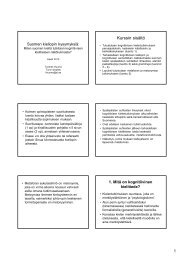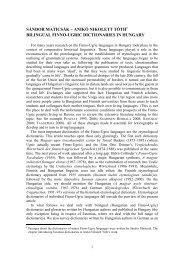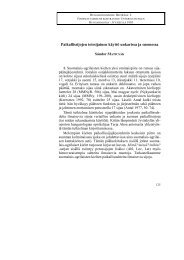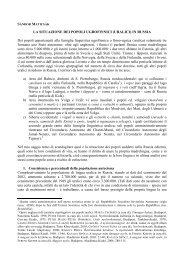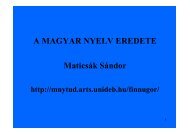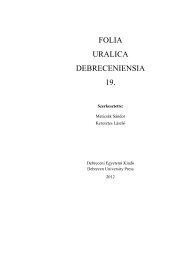Allomorphic variants of Erzya-Mordvin nominal derivational suffixes
Allomorphic variants of Erzya-Mordvin nominal derivational suffixes
Allomorphic variants of Erzya-Mordvin nominal derivational suffixes
You also want an ePaper? Increase the reach of your titles
YUMPU automatically turns print PDFs into web optimized ePapers that Google loves.
<strong>Allomorphic</strong> <strong>variants</strong> <strong>of</strong> <strong>Erzya</strong>-<strong>Mordvin</strong> <strong>nominal</strong> <strong>derivational</strong> <strong>suffixes</strong>MATICSÁK Sándor1. In one <strong>of</strong> my earlier papers (Maticsák 2003), I have already examined the linking rules <strong>of</strong><strong>Erzya</strong>-<strong>Mordvin</strong> case endings. The present paper widens the sphere <strong>of</strong> this inquiry and takes up<strong>nominal</strong> <strong>derivational</strong> <strong>suffixes</strong> as well. The linking rules <strong>of</strong> <strong>Mordvin</strong> <strong>derivational</strong> <strong>suffixes</strong> are veryintricate. Besides palatovelar vowel harmony, defined by tonal characteristics <strong>of</strong> the vowels, thereare other important factors influencing the linking rules: whether the stem-final consonant ispalatalized or not; whether it is voiced or voiceless; stem-final vowel/consonant oppositions; andthe presence or absence <strong>of</strong> consonant clusters. One <strong>of</strong> these factors, namely the opposition <strong>of</strong>palatal and non-palatal consonants, is unique, being characteristic only to the <strong>Mordvin</strong> language(cf. Keresztes 1983: 366–368; Rédei 1982: 176; 1984: 229; Zaicz 1993: 428–243; 1998: 190).This opposition <strong>of</strong>ten overrules even the palatovelar opposition and becomes the most importantamong the linking rules.<strong>Mordvin</strong> handbooks and grammar summaries are <strong>of</strong>ten inconsistent in the discussion <strong>of</strong> thelinking rules applied when <strong>suffixes</strong> are added to stems. First, I am going to give a survey <strong>of</strong> theseinconsistencies here (which are due to the mixing <strong>of</strong> the synchronic and diachronic linguisticaspects on the one hand and the difficulties <strong>of</strong> using Cyrillic letters on the other), then I am goingto attempt to create a uniform framework for the description <strong>of</strong> linking rules for <strong>Erzya</strong> <strong>nominal</strong><strong>derivational</strong> <strong>suffixes</strong>.Two <strong>of</strong> the basic problems in <strong>Mordvin</strong> suffixation are the handling <strong>of</strong> the vowel between thestem and the <strong>suffixes</strong>, and the deletion <strong>of</strong> the last vowel (or syllable) <strong>of</strong> the stem. According to thecomprehensive handbook published in 1980 (Grammatika 153–154), <strong>Mordvin</strong> <strong>nominal</strong>s can haveeither one (e.g. лопа ‘leaf’) or two roots (e.g. чувто ‘tree’), and in the course <strong>of</strong> suffixation, thestem-final vowel <strong>of</strong> <strong>nominal</strong>s with two roots is deleted before certain <strong>suffixes</strong>/case endings:чувто-нь Gen., but чувт-со Iness. Somewhat surprisingly, words like вирь ’forest’ : вире-ньGen., вире-в Lat. (but вир-де Abl., вирь-сэ Iness) or ош ’town’ : ошо-нь Gen., ошо-в Lat. (butош-сто Elat., ош-ка Prol. etc.) are also considered to have got two roots, which means that thisapproach considers the vowel preceding the suffix to be part <strong>of</strong> the stem. The linking rules <strong>of</strong> thetranslative (эйкакш ’child’ : эйкакшо-кс) and the comparative (венч ’boat’ : венче-шка) isdescribed there in a similar way. The quality <strong>of</strong> the vowel preceding the suffix depends on thevowel in the stem and the stem-final consonant. The handbook in question – using a curiouscombination <strong>of</strong> orthographic and phonetic-morphologic aspects – introduces one more categorybesides suffix alternations resulting from the palatal/velar quality <strong>of</strong> the vowel and the hard/s<strong>of</strong>tconsonant opposition: the usage <strong>of</strong> the letters э and e, separating in the Cyrillic written forms <strong>of</strong>the words. According to the authors’ view, the -o- sound is attached to back-vocalic words endingin a hard consonant (сан ’vein’: сано-нь Gen.); the sound marked with e in the Cyrillic alphabet[je] is added to front (or back) vocalic words ending in a s<strong>of</strong>t vowel, j, or a palatal consonant:умарь ’apple tree’ : умаре-нь, лей ’river’ : лее-нь, ломань ’person’ : ломане-нь, кев ’stone’ :кеве-нь. Front-vocalic words ending in a hard consonant get the letter э [e]: верьгиз ’wolf’ :верьгизэ-нь, нартемкс ’Artemisia’ : нартемксэ-нь (Grammatika 1980: 155–159).The <strong>Erzya</strong> handbook published in 2000 (EK 78–82) employs similar guiding principles. Theauthors give the case endings <strong>of</strong> the genitive, lative, translative and comparative without theadditional vowel, but they indicate that vowel in the sample paradigm, sometimes considering itas a connective vowel (ош ’town’ : ош-о-кс, ош-о-шка), sometimes a stem-final vowel (ошо-нь,ошо-в). Cyrillic transliteration causes difficulties in this book as well: the лей : ле-е-нь approachis somewhat unfit for the <strong>Mordvin</strong> morpheme alternation studies, and the usage <strong>of</strong> the letters e/эalso appears in the description <strong>of</strong> the <strong>suffixes</strong> mentioned above.1
This concept is even more curious in the <strong>Erzya</strong> coursebook written by Mosin–Bajuškinpublished in 1983 (47). This book uses Finnish as an intermediary language, but gives the <strong>Erzya</strong>word forms in Cyrillic letters. The authors use the system outlined above for the explanation <strong>of</strong>the linking rules, this is why one can read the following in the description <strong>of</strong> the genitive: „c)sidevokaalin e välityksellä, jos vartalon viimeinen äänne on liudentunut dentaali...”, d)sidevokaalin э välityksellä, jos vartalon viimeinen äänne on liudentumaton dentaali...” 1In his unilingual dictionary <strong>of</strong> definitions published in 2002, Abramov tries to resolve thecontradiction between Cyrillic transcription and the existence <strong>of</strong> palatalized consonants in alogical but peculiar way: кед|ь, - ьсе, -ень, -не. A positive aspect <strong>of</strong> Abramov’s approach is thathe treats the additional vowel in expressly as part <strong>of</strong> the suffix.As regards literature written by foreign linguists: Alo Raun (1988: 100–101) lists the wordforms without the additional vowel (Gen. -ń, Illat. -v and -s, Translat. -ks, Comp. -ška), but as heonly included words ending in a vowel, he got around the problem in effect. The book titledChrestomathia Morduinica partly follows the connective vowel conception – kal ’fish’ : kal-o-ń,keď ’hand’ : keď-e-ń (Gen.); karks ’belt’ : karks-o-ks, piks ’rope’ : piks-e-ks (Translat.) – however,it also applies the stem-final vowel theory to some extent – oš ’town’ : ošo-v, viŕ ’forest’ : viŕe-v(Lat.); karks : karkso-ška (Comp.) (Keresztes 1990: 54–55). In his latest monography (2011: 64–65), László Keresztes treats the vowel in question as part <strong>of</strong> the suffix: kal-oń, keď-eń. EditMészáros also gives preference to the descriptive aspect in her <strong>Mordvin</strong> coursebook (1998: 17, 18,31, 77): mastor ’land, country’ : mastor-oń, lomań ’person’ : lomań-eń (Gen.); oš-ov, viŕ-ev(Lat.); vaz ’calf’ : vaz-oška, ľej ’river’ : ľej-eška (Comp.); ruz ’Russian’ : ruz-oks, šved ’Swedish’: šved-eks (Translat.). The same principle is applied by Gábor Zaicz in his comprehensive essay(1998: 191–194): the vowel belongs to the suffix, cf. viŕ-eń, viŕ-ev.Bartens (1999: 70–73) divides the <strong>nominal</strong> roots into four classes (the second <strong>of</strong> which is onlyrelevant in terms <strong>of</strong> the Moksha dialect). The first group is that <strong>of</strong> the roots ending in a vowel(moda ’land’ : moda-ń Gen.); in the second class, there are Moksha roots which contain a reducedvowel in place <strong>of</strong> the full vowel <strong>of</strong> the <strong>Erzya</strong> forms (E veľe ’village’ : veľe-ń Gen., M veľä : veľəń);the third group contains roots which allow for certain <strong>suffixes</strong> to drop the stem-final vowel(e.g. pargo ’basket’ : park-sto Elat.; this change <strong>of</strong>ten goes together with the devoicing <strong>of</strong> thestem-final consonant); 2 and the fourth class, which is the most interesting for our purposes, is theone that comprises roots ending in a consonant. Bartens follows the same principle as theGrammatika: he takes up the kal- and kalo-, or viŕ- and viŕe- type roots.On the whole, we can say that <strong>Mordvin</strong> linguists and Raija Bartens treat the additional vowelas part <strong>of</strong> the stem and differentiate between two types <strong>of</strong> <strong>nominal</strong> roots, while Hungarianlinguists give preference to the descriptive aspect and consider this vowel as part <strong>of</strong> the suffix(similarly to the changes observable in Hungarian: Proto-Hun. hala : hala-t Acc. > after thedeletion <strong>of</strong> the stem-final vowel: hal-at Acc. hal-ban Iness. etc.)2. There are five distinctive features we must take into consideration when discussing thelinking rules <strong>of</strong> case endings:a) whether the stem ends in a vowel or a consonant;b) whether the stem ends in a single consonant or a consonant cluster;c) whether the vowel in the last syllable palatal or velar;d) whether the stem-final consonant is palatal or non-palatal (s<strong>of</strong>t or hard);e) whether the stem-final consonant is voiced or voiceless.1 [c) an e connective vowel is added when the last sound <strong>of</strong> the stem is s<strong>of</strong>t dental, d) an э connective vowel isadded when the last sound <strong>of</strong> the stem is hard dental]2 In 1993, the new orthographic system reflecting morpheme boundaries made the pando ’hill’ : pando-so formsnormative instead <strong>of</strong> the pando : pand-so, since those do not get shortened. However, syllable deletion is animportant element in the course <strong>of</strong> suffixation.2
I have already examined the relationship <strong>of</strong> stems and case endings in detail in my abovementioned paper (Maticsák 2003: 146–160), therefore only a short survey is given about this topichere.GenLatInessElatProlDatAblAbeTrsComIllata) -V / -C + + – – + (+) (+) + + + –b) -C / -CC – – – – – – (+) – + + –c) -V- pal/vel + + + + – – + + + + –d) -C pal/nonpal + + + + – + + + + + –e) -C v.d/v.less – – – – + – + – – – –The distinctive features do not play equally important roles in the formulation <strong>of</strong> rules: themost significant aspects are the stem-final vowel/consonant oppositions, palatovelar vowelharmony, and consonant harmony (being a unique characteristic <strong>of</strong> <strong>Mordvin</strong>). Stem-finalconsonant clusters and the voiced/voiceless opposition are significantly less relevant factors. It isthe ablative that requires the most distinctive features to be involved, while the fewest aspectsneed to be considered for the illative. Based on these facts, from a descriptive aspect, the <strong>Mordvin</strong><strong>nominal</strong> case endings can be listed as follows (handbooks usually give only the forms that do notinclude the initial vowels):Genitive -ń, -eń, -oń Lative -v, -ev, -ovTranslative -ks, -eks, -oks Comparative -ška, -eška, -oškaInessive -se, -so Elative -ste, -stoProlative -va, -ga, -ka Dative -neń, -ńeńIllative -s Ablative -de/-ďe/-do/-te/-ťe/-toAbessive -vťeme/-vtomo/-teme/-ťeme/-tomo3. The literature on the subject matter direct little attention to the linking rules <strong>of</strong> <strong>derivational</strong><strong>suffixes</strong>. Evsev’ev’s grammar (1963/1931), the first grammatical summary <strong>of</strong> pr<strong>of</strong>essionalcharacter, already discussed <strong>derivational</strong> affixes in a systematic way (38–44), but failed toexamine linking issues, the same way as the handbook titled Grammatika published in 1962 (39–43), and the volume about the <strong>Mordvin</strong> language in Feoktistov’s 1966 series describing thelanguages <strong>of</strong> the former Soviet Union (182–183) did. A more recent handbook, the 1980Grammatika, presented this category in considerably more detail, with abundant material (103–115), but the subject matter the present paper examines was mentioned only in the case <strong>of</strong> one ortwo <strong>suffixes</strong>. The latest <strong>Erzya</strong> descriptive grammar handbook (EK 2000: 35–39) also discussesthis topic in a well-organized fashion, though very briefly, and it does not mention any linkingrules. Serebrennikov writes about questions <strong>of</strong> origin <strong>of</strong> the <strong>derivational</strong> affixes in his <strong>Mordvin</strong>historical grammar (1967: 66–71, 75–79), however, linking issues are missing from here as well.D. V. Cygankin’s monograph (1981) on <strong>nominal</strong> derivation (and <strong>nominal</strong> compounds to a littleextent) touches upon certain problems <strong>of</strong> linking in suffixation, but he either does not direct muchattention to this phenomenon. László Keresztes’s chrestomathy from 1990 (65–67) and his latestcomprehensive book (2011: 122) introduce us into word-formation briefly, in a list-like manner,but the linking rules are not discussed in these works either. The subject is treated in a relativelydetailed way in Raija Bartens’s Finnish language manual (1999: 106–107, 110–111), and differentproblems <strong>of</strong> suffixation are examined in the case <strong>of</strong> a few <strong>of</strong> the <strong>suffixes</strong> described. Edit Mészárosprovides a good summary about <strong>derivational</strong> <strong>suffixes</strong> in her coursebook (1998: 41, 50, 59, 79–80,98–99, 102, 140), and she is the one who does so through a more or less consistent combination <strong>of</strong>descriptive and historical approaches.3
According to Cygankin’s (1981: 30–31) and the Grammatika’s approach (1980: 103–115),these <strong>derivational</strong> <strong>suffixes</strong> always take the -C, -CC etc. forms, and if there is a vowel to be foundbefore them, that is part <strong>of</strong> the stem (as could be seen in the case <strong>of</strong> case endings) or an elementcalled “interfix” (a term applied by Cygankin and the Grammatika), that is a connective vowelbelonging to “no man’s land” (Cygankin 2006: 6–7).On the whole, we can say that the linking rules <strong>of</strong> <strong>nominal</strong> <strong>derivational</strong> <strong>suffixes</strong> are moresimple than that <strong>of</strong> the case endings, however, in the case <strong>of</strong> derivation not only allomorphicvariations are to be discussed, but stem-endings can also be modified. The distinctive features arethe following:Modifications affecting the stem:a) the stem-final vowel is/is not deletedb) the last syllable <strong>of</strong> the stem is/is not deletedModifications affecting the suffix:c) the presence/absence <strong>of</strong> a connective vowel:→ -C(…) or -VC(…) type <strong>suffixes</strong>d) the palatal/velar quality <strong>of</strong> the vowel in the last syllable:→ -VpalC or -VvelC type <strong>suffixes</strong>e) the palatal/non-palatal (hard/s<strong>of</strong>t) quality <strong>of</strong> the stem-final consonant→ C(…) or C’(…) type <strong>suffixes</strong>As opposed to that <strong>of</strong> the case endings, the linking rules <strong>of</strong> <strong>derivational</strong> <strong>suffixes</strong> are notinfluenced by whether the stem ends with a vowel or a consonant; or whether the stem-finalconsonant is voiced or voiceless. In the last, f) section, vowel alternations <strong>of</strong> the stem and thesuffix are going to be discussed.Of the <strong>nominal</strong> <strong>derivational</strong> <strong>suffixes</strong>, only the productive and semantically transparent onesare going to be examined here. The discussion excludes <strong>suffixes</strong> with obscured meanings and onlyetymologically traceable functions. The <strong>suffixes</strong> are given in the format most used in the relatedliterature (e.g. -v), and when any modifications are deemed necessary, that will be indicated (e.g. -v, -ov, -ev). To save space, distinctive features that are not characteristic to the given suffix are notgoing to be listed.3.1. -C type <strong>suffixes</strong>3.1.1. The de<strong>nominal</strong> adjectival suffix, -ń is highly frequent and productive, attachable to almostany <strong>nominal</strong>s (Bartens 1999: 111; EK 38; Feoktistov 1966: 183; Grammatika 1980: 112–113;Keresztes 1990: 66; Mészáros 1998: 41; Serebrennikov 1967: 78). Its linking rules are the same asthat <strong>of</strong> the genitive and lative case endings taking the same form. From a descriptive point <strong>of</strong> view,the <strong>derivational</strong> suffix takes up the -ń/-eń/-oń forms (however, the handbooks all give it in the -ńform).c) After stems ending in a vowel, the form <strong>of</strong> the suffix is -ń (ľišmeń ’horse (as first constituent <strong>of</strong>a compound)’ ← ľišme ’horse’, raśkeń ’relative (as first constituent <strong>of</strong> a compound)’ ← raśke’relative’, veľeń ’village (as first constituent <strong>of</strong> a compound)’ ← veľe ’village’); after stemsending in a consonant, it takes up the -Vń form.d) After front-vocalic stems, the suffix is -eń (ťejťeŕeń ← ťejťeŕ ’girl’), and the same form isattached to non-harmonic stems ending in a palatal vowel (tuŕisteń ← tuŕist ’tourist’). The -ońvariant is used after back-vocalic stems: vatrakšoń ← vatrakš ’frog’, šokoladoń ← šokolad’chocolate’.e) When the stem-final consonant is palatalized, the suffix takes up the -eń form (even if the stemis back-vocalic!): inźejeń ← inźej ’raspberry’, kaľeń ← kaľ ’willow’, ľejeń ← ľej ’river’, lomańeń← lomań ’person’, modamaŕeń ← modamaŕ ’potato’, śeďejeń ← śeďej ’heart’. The -oń form isused if the stem-final consonant is non-palatalized: vatrakšoń).4
3.1.2. The -v suffix is also a frequent and productive de<strong>nominal</strong> adjectival suffix (Bartens 1999:110–111; Cygankin 1981: 46–47; EK 38; Feoktistov 1966: 183; Grammatika 1962: 41–42;Grammatika 1980: 112; Keresztes 1990: 66; Mészáros 1988: 102; Serebrennikov 1967: 78–79). Itslinking rules are the same as that <strong>of</strong> the genitive and lative case endings. From a descriptive point <strong>of</strong>view, the suffix takes up the -v/-ev/-ov forms (although, only Mészáros uses this form).c) After stems ending in a vowel, it is -v (piźemev ’rainy’ ← piźeme ’rain’, usav ’moustached’ ←usa ’moustache’, varmav ’windy’ ← varma ’wind’); after stems ending in a consonant, it takesup the -Vv form.d) After front-vocalic stems, the form <strong>of</strong> the suffix is -ev (kevev ’stony’ ← kev ’stone’, kežev’angry’ ← kež ’anger’, ľemev ’fatty’ ← ľem ’fat’); after back-vocalic stems, it is -ov: porov’chalky’ ← por ’chalk’, počtov ’floury’ ← počt ’flour’, rudazov ’muddy; dirty’ ← rudaz’mud’, sakalov ’bearded’ ← sakal ’beard’.e) When the stem-final consonant is palatalized, the suffix is used in the -ev variant (even if thestem is back-vocalic!): čemeńev ’rusty’ ← čemeń ’rust’, vijev ’strong’ ← vij ’strength’; umaŕev’made with apples’ ← umaŕ ’apple’, śovońev ’clayey’ ← śovoń ’clay’. The -ov form is used ifthe stem-final consonant is non-palatalized: (rudazov).3.1.3. The -j suffix is synonymous with the former -v, with the difference that it is considerablyless frequent (Bartens 1999: 110–111; Cygankin 1981: 46–47; EK 38; Feoktistov 1966: 183;Grammatika 1980: 112; Keresztes 1990: 66; Mészáros 1998: 102; Serebrennikov 1967: 78–79).From a descriptive point <strong>of</strong> view, the suffix takes up the -j, -ej forms, although only Mészáros givesthese forms and we find -j in all the other sources.c) After stems ending in a vowel, the form <strong>of</strong> the suffix is -j (keľej ’wide; spacious’ ← keľe’width’, pitńej ’expensive’ ← pitńe ’price; value’, sepej ’bitter’ ← sepe ’bile; bitter taste’);after stems ending in a consonant, an additional -e connective vowel is added before the suffix(kežej ’angry’ ← kež ’anger’, pŕevej ’clever’ ← pŕev ’reason, sense’). 33.1.4. The -t, -ť suffix is not productive anymore. It is infrequent as a suffix <strong>of</strong> de<strong>nominal</strong> nouns, butsomewhat more common as a deverbal suffix (Cygankin 1981: 46; 2000c: 149–150; EK 37;Grammatika 1980: 107; Keresztes 1990: 67; 2011: 46).a) The stem-final vowel is deleted when the suffix is added to verbal stems: košt ’air’ ← košta- ’to(become) dry, to wither’, ťeńśť ’broom’ ← ťeńśe- ’to sweep’, veťśť ’rein, leash’ ← vetśe- ’tolead, to carry somewhere’.b) Sometimes – when the suffix is not added to a passive root, but a verbal derivative word – theentire last syllable <strong>of</strong> the verbal stem may be deleted: pečť ’piece, slice’ ← pečke- ’to cut (<strong>of</strong>f)’,počt ’flour’ ← počodo- ’to sprinkle, to powder’, śolt ’pond’ ?← śolgo- ’to shut, to close’.c) It is added to de<strong>nominal</strong> stems ending in a consonant without a connective vowel inserted: gajť’sound, voice’ ← gaj ’ringing, noisy’, onkśť ’bridle-bit’ ?← onks ’moderation’. Inonomatopoeic words, the suffix is attached to a semantically obscure passive root (not existingindividually anymore) ending in a consonant: šalt ’hum, clamour, noise’ (cf. šalno- ’to hum, toclamour’), uvt ’hum’ (cf. uvno- ’to hum’), zujť ’shiver’ (cf. zujńe- ’to tremble, to shiver’), źeŕť’rumble’ (cf. źeŕńe- ’to rumble’).d) The -ť variant is used after front-vocalic stems (pečť, ťeńśť), the -t after back-vocalic stems(košt, počt).e) The suffix takes up the -ť form after stems ending in a palatalized consonant (even if the stemis back-vocalic!): gajť, ťeńśť, zujť; the -t variant is used after stems ending in a non-palatalizedconsonant (košt, šalt).3 C.f. in addition tanťej ’tasty; sweet’, which probably goes back to the tan-/tant- root, c.f. tanśť ’taste; sweets’.5
3.1.5. Another infrequent suffix observable in onomatopoeic (mainly sound imitating) words isthe -k (Cygankin 1981: 56).c) It is attached to the passive root directly, without the addition <strong>of</strong> a connective vowel: boldork(splash), buńk (thud), ćiŕk (crack), ćivťork (glitter, sparkle), ćotork (creak, carsh), jombolk(quick activity), jozmolk (quick movement), juvk, jurk (whisking), kalck (knocking), ľibork(swishing <strong>of</strong> wings), rovck (thump), sork (tremor, startling), tock (sudden, unexpectedmovement), zerk (thump), žojk (splash).3.2. -CC type <strong>suffixes</strong>3.2.1. Suffix -ks is one <strong>of</strong> the most frequent and most productive <strong>suffixes</strong> in the de<strong>nominal</strong> anddeverbal use, although it is considerably less frequent as a deverbal adjectival suffix (Bartens1999: 106–107; Cygankin 1981: 35–41; 2000c: 142–145; EK 36, 38; Feoktistov 1966: 182;Grammatika 1962: 39–40; Grammatika 1980: 104–105; Keresztes 1990: 66, 67; Mészáros 1998:41; Serebrennikov 1967: 68–69).a) The stem-final vowel <strong>of</strong> verbal stems is usually deleted: poladks ’addition’ ← polado- ’to add’,potomks ’plug, cork’ ← potomo- ’to get plugged up’, tavadks ’cover, blanket’ ← tavado- ’tocover’, ušodks ’beginning’ ← ušodo- ’to begin’, vačkoťks ’blow, punch’ ← vačkoďe- ’to hit’.This modification is rarer in the case <strong>of</strong> <strong>nominal</strong>s (especially in the case <strong>of</strong> nouns derived fromadverbs): ikeľks ’front part <strong>of</strong> something’ ← ikeľe ’in front’, udalks ’back part <strong>of</strong> something’←udalo ’at the back’, veŕks ’top part <strong>of</strong> something’ ← veŕe ’top, higher’.b) Sometimes the entire last syllable <strong>of</strong> the verbal stem may be deleted: keńarks ’joy’ ← keńardo-’to be glad’, kučkorks ’kick’ ← kučkordo- ’to kick’, ľezks ’help’ ← ľezda- ’to help’, śangorks’pain’ ← śangordo- ’to ache, to hurt’.c) The same -ks form is used after stems ending in a vowel or in a consonant alike, therefore thisis not a distinctive feature: čamaks ’mask, disguise’ ← čama ’face’, kiks ’line, stroke’ ← ki’way, path’, piľeks ’earring’ ← piľe ’ear’, and ińźejks ’raspberry bush’ ← ińźej ’raspberry’,jamks ’millet; grits’ ← jam ’soup’, keďks ’bracelet’ ← keď ’hand’, mastorks ’ground; floor’ ←mastor ’earth, soil’, umaŕks ’apple tree’ ← umaŕ ’apple’, valks ’dictionary’ ← val ’word’. 4f) The -o > -a change is a modification happening only rarely: potmaks ’bottom; channel’ ←potmo ’inside <strong>of</strong> something; interior’, palaks ’nettle’ ← palo- ’to burn’.3.2.2. Since -kš is very rare and unproductive as a <strong>nominal</strong> or adjectival suffix, (Bajuškin 1973:75–77; Cygankin 1981: 40–41; 2000c: 145–146; EK 36; Feoktistov 1966: 182; Grammatika 1962:39; Grammatika 1980: 105, 111; Keresztes 1990: 66; Serebrennikov 1967: 68–69), it is somewhatdifficult to infer rules from the data available.c) The words with surely traceable derivation all end in a vowel that is not deleted when a suffixis added: avakš ’hen(-bird)’ ← ava ’woman, housewife, mother’, aťakš ’rooster’ ← aťa ’oldman’. I could not find any words in the data available that ends in a consonant, therefore we donot have information about whether a connective vowel is added before the suffix or not.However, as this suffix is a variant <strong>of</strong> -ks, it may only have a single form as well, in allprobability.f) Further modifications: the vowel standing before the suffix changes in its tone: śurakš ’horned’← śuro ’horn’; jutkakš ’alley, passage-way’ ← jutko ’(time/space) interval, distance, ’ (а ← о);4 The translative case ending is usually added with a connective vowel (cf. Maticsák 2003: 156–158), thus thetwo types <strong>of</strong> -ks is clearly separable in terms <strong>of</strong> form as well – at least in stems ending in a consonant: sur-oks’finger (Translat.)’ – sur-ks ’ring’; meńeľ-eks ’sky (Translat.)’ – meńel-ks ’weather’; piźol-oks ’sorb (Translat.)’ –piźol-ks ’sorb tree’ etc. (However, at the same time, stems ending in a vowel are homonymous: ľeńge-ks’linden (Translat.)’ and ’linden-tree’ etc.6
śelmukš-t (plur.) ’glasses’ ← śelme ’eye’, piľukš ’having sharp hearing; crested’ ← piľe ’ear’ (u← е). It is problematic, however, if we can consider the -akš/-ukš <strong>variants</strong> (after the deletion <strong>of</strong>the stem-final vowel) as existing forms from a descriptive point <strong>of</strong> view.3.2.3. The -vt suffix is a de<strong>nominal</strong> and deverbal, not too productive <strong>nominal</strong> suffix (Cygankin1981: 39; Mészáros 1998: 41).c) The little data found all end in a vowel: avavt ’mother-in-law’ ← ava ’woman, housewife;mother’, aťavt ’father-in-law’ ← aťa ’old man; husband’, pŕavt ’boss’ ← pŕa ’head’, or čalgavt’step’ ← čalga- ’to step’, jakavt ’walking’ ← jaka- ’to walk’, oršavt ’clothing’ ← orša- ’to getdressed’, piŕavt ’fence’ ← piŕa- ’to fence, to enclose’, vanovt ’glance’ ← vano- ’to look at’.3.3. -CCC type <strong>suffixes</strong>3.3.1. The -vks is a deverbal <strong>nominal</strong> suffix. It is productive and frequent (Bartens 1999: 107; EK36; Cygankin 1981: 39–40; 2000c: 145; Grammatika 1980: 105; Mészáros 1998: 59).c) Because this suffix forms verbs only, it is attached to verbal stems ending in a vowel, andinstances where it is added to a stem-final consonant cannot be found: aŕśevks ’idea,conception’ ← aŕśe- ’to think (about)’, artovks ’painting, drawing’ ← arto- ’to paint, to draw’,izavks ’harrowing’ ← iza- ’to harrow’, kemevks ’belief, trust’ ← keme- ’to believe’, meŕevks’expression’ ← meŕe- ’to tell’, ńevťevks ’example, specimen’ ← ńevťe- ’to show’, oršavks’clothing, garment’ ← orša- ’to get dressed’, targavks ’cigarette-end’ ← targa- ’to smoke’.3.3.2. The -kśť suffix is added to numerals to express multiplication <strong>of</strong> the given number(Grammatika 1962: 40; Grammatika 1980: 363; Mészáros 1998: 68–69).b) There are two cases when the last syllable <strong>of</strong> the stem is deleted: kavkśť ’twice’ ← kavto ’two’,veśť ’once’ ← vejke ’one’ (here the suffix itself has got a different form as well).c) It is attached to numerals ending in a vowel directly: kolmokśť ’three times’ ← kolmo ’three’,ńiľekśť ’four times’ ← ńiľe ’four’, veťekśť ’five times’ ← veťe ’five’, śadokśť ’a hundred times’← śado ’hundred’ etc.; lamokśť ’a lot <strong>of</strong> times’ ← lamo ’a lot <strong>of</strong>’, źarijakśť ’a few times’ ←źarija ’a few’. The numeral śiśem ’hét’ ends in a consonant, therefore a connective vowel isadded before the suffix (śiśemekśť), this is why, from a descriptive point <strong>of</strong> view, the suffixtakes up the -kśť, -ekśť forms.3.4. -CV type <strong>suffixes</strong>3.4.1. The -mo, -ma, -me suffix is one <strong>of</strong> the most common deverbal <strong>suffixes</strong>. It is highlyproductive and very frequent; its basic function is to create abstract nouns (Bartens 1999: 106;Cygankin 1981: 41–42; 2000c: 146–147; EK 36; Grammatika 1980: 105–106; Keresztes 1990:67; Mészáros 1998: 59; Serebrennikov 1967: 70).a) In very rare cases, the stem-final vowel may be deleted: ľiśma ’well, fountain’ ← ľiśe- ’to comeout; to creep forth’, viďme ’seed’ ← viďe- ’to sow’.c) Except for the instances given above, this suffix always connects to verbal stems ending in avowel.f) The choice between the three allomorphic <strong>variants</strong> <strong>of</strong> the suffix depends on the last vowel <strong>of</strong> thestem: verbs ending in -a get the -mo variant (kortamo ’speech; chat’ ← korta- ’to speak, totalk’, ľezdamo ’help’ ← ľezda- ’to help, to assist’, moramo ’singing’ ← mora- ’to sing’,oršamo ’clothing, garment’ ← orša- ’to get dressed’, ozamo ’chair, small seat’ ← oza- ’to sit(down)’); verbs with a stem-final -o or -e are followed by the -ma allomorph (kemema ’belief;trust’ ← keme- ’to believe; to trust’, kuloma ’death’ ← kulo- ’to die’, moľema ’going, walking’← moľe- ’to go, to walk’, pejďema ’laughter’ ← pejďe- ’to laugh’, and also mizoldoma ’smile’← mizoldo- ’to smile’, pŕadoma ’ending’ ← pŕado- ’to end, to finish’, śavadoma ’envy’ ← śa-7
vado- ’to envy’, udoma ’sleep; dream’ ← udo- ’to sleep’). Verbal stems ending in -eoccasionally get the -me variant: piźeme ’rain’ ← piźe- ’to rain’, suvťeme ’sieve’ ← suvťe- ’tosift’, viďme ’seed’ ← viďe- ’to sow’.3.4.2. A large group <strong>of</strong> <strong>Mordvin</strong> diminutive forms is words created with the -ka, -ke suffix(Bartens 1999: 106; Cygankin 1981: 58–60; 2000c: 154–156; EK 37; Feoktistov 1966: 182;Grammatika 1962: 40; Grammatika 1980: 109–111; Keresztes 1990: 66; Mészáros 1998: 41;Serebrennikov 1967: 68). (Another group is that <strong>of</strong> the words formed with the more frequent andmore productive -ńe, -ne, -ińe, cf. section 3.4.3. and 3.8.3.)c) Suffix -ka, -ke is usually attached to stems ending in a consonant:: sazorka ’little sister’ ←sazor ’one’s younger sister’, ťejťeŕka ’little girl’ ← ťejťeŕ ’girl’; avakške ← avakš ’tyúk’,jalakske ← jalaks ’younger brother’, jovkske ← jovks ’tale’, oške ← oš ’town’, peľkske ←peľks ’part’, penčke ← penč ’spoon’, ŕiveźke ← ŕiveź ’fox’, sarazke ← saraz ’hen’. The -kasuffix can sometimes connect to stems ending in a consonant, if the word derived nicknamesrelatives, people or animals as folk tale characters, and in these special cases, the suffix goestogether with the vocative: avaka-j ’my little mother (Voc.)’, ćoraka-m ’my little sonny(PxSg1)’, Miťaka-j ’little Mitja (Voc.)’, Ovtoka-j ’little bear, bear cub (Voc.). – This suffix andthe Russian origin -ka diminutive suffix are the same in form. The latter can be found in a lot <strong>of</strong>words that have already assimilated to the <strong>Mordvin</strong> vocabulary: лампочка ’little lamp’, машинка’smaller machine’, молотка ’hammer’, таблетка ’pill’, тетрадка ’notebook’, этикетка’label, price tag’ etc.3.4.3. Besides the -ka diminutive suffix, there is another -ka de<strong>nominal</strong> <strong>nominal</strong> suffix that hasbecome very infrequent (Cygankin 1981: 42–44; 1999: 8–9; 2000c: 147–148; EK 36–37;Feoktistov 1966: 182; Grammatika 1962: 40, Grammatika 1980: 106; Serebrennikov 1967: 68).c) This suffix is added to stems containing a stem-final vowel in the following words: avaka’female (mammal)’ ← ava ’woman, housewife; mother’, aťaka ’male (mammal)’ ← aťa ’oldman’. Some animal names are also susceptible to contain this suffix: maksaka ’mole’ (its otherform is maksaźej) maraka ~ marav ’wine fly’, oźaka ~ oźaz ’sparrow’, śeźaka ~ śeźgan’magpie’.3.4.4. A further large group within the class <strong>of</strong> diminutive <strong>suffixes</strong> is that <strong>of</strong> the highly frequentand productive -ne, -ńe, -ińe <strong>suffixes</strong> (Bartens 1999: 106; Cygankin 1981: 58–60; 2000c: 154–156; EK 37; Feoktistov 1966: 182; Grammatika 1962: 40; Grammatika 1980: 89, 109–111;Keresztes 1990: 66; Mészáros 1998: 41; Serebrennikov 1967: 69). One <strong>of</strong> these, the -ińe suffix,will be discussed in the 3.8.3. section.c) This suffix is exclusively attached to stems ending in a consonant (for stems ending in a vowelget the -ińe variant): lejńe ← ľej ’river’, ľemńe ← ľem ’name’.e) If the stem-final consonant is palatal, the -ńe variant is added to the word, and if it is nonpalatal,the -ne allomorph is attached: peľńe ← peľ ’part’, ťejťeŕńe ← ťejťeŕ ’girl’; also kevne← kev ’stone’, taradne ← tarad ’branch’, valne ← val ’word’.3.4.5. The -će de<strong>nominal</strong> suffix can sometimes be found in words naming space and time relations(attached to adverbs), but its main function is to form ordinal numbers (EK 38, 122–123; Grammatika1980: 113; Keresztes 1990: 65; Mészáros 1998: 41; Serebrennikov 1967: 119–120). Froma descriptive point <strong>of</strong> view, its form is -će, -eće, although this conception appears only inMészáros’s work.a) When used in the former function, the stem-final vowel is deleted before the suffix (ikeľće’preceding, front(al)’ ← ikeľe ’in front’, udalće ’hind, posterior’ ← udalo ’at the back’, veŕće8
’upper’ ← veŕe ’upper’), but it is preserved after numerals (kolmoće ’third’ ← kolmo ’three’,ńiľeće ’fourth’ ← ńiľe ’four’).c) After numerals ending in a consonant, the suffix takes up the -eće (śiśemeće ’seventh’ ← śiśem’seven’, komśeće ’twentieth’ ← komś ’twenty’) and (after round numbers) the -će forms(kemeńće ’tenth’ ← kemeń ’ten’, kolońgemeńće ’thirtieth’ ← kolońgemeń ’thirty’,ńiľeńgemeńće ’fortieth’ ← ńiľeńgemeń ’forty’ etc.)3.4.6. The -la de<strong>nominal</strong> adjectival suffix serves for the expression <strong>of</strong> some kind <strong>of</strong> characteristicfeature. It is not productive anymore (Bajuškin 1977: 80–84; Cygankin 1981: 52; EK 39;Feoktistov 1966: 183; Grammatika 1980: 113; Keresztes 1990: 67; Serebrennikov 1967: 75).c) It is attached to <strong>nominal</strong> stems ending in a vowel: ašola ’whitish, pale’ ← ašo ’white’, čavola’stupid, short-witted’ ← čavo ’empty’, čuvtola ’wooden-headed, pigheaded’ ← čuvto ’wood’,ečkela ’plump’ ← ečke ’thick; fat’, načkola ’damp, moist’ ← načko ’damp, moist’, ožola’yellowish’ ← ožo ’yellow’, pižela ’greenish’ ← piže ’green’, taštola ’archaic’ ← tašto ’old’.3.4.7. A rare and unproductive de<strong>nominal</strong> adjectival suffix is the -ža that is used for theexpression <strong>of</strong> a quality (Bajuškin 1977: 75–78; Cygankin 1981: 54–55; EK 39; Feoktistov 1966:183; Grammatika 1980: 113, 114; Keresztes 1990: 67; Serebrennikov 1967: 77).c) It is attached to <strong>nominal</strong> stems ending in a vowel: alkaža ’shortish’ ← alka ’short; shallow’,ľembeža ’warm’ ← ľembe ’warm’, nolaža ’slippery’ ← nola ’fluid, moisture’. If the suffix isattached to stems ending in a consonant, the suffix takes the -aža and -iža form: seńaža ’bluish’← seń ’blue’ (but: beŕaža ’weakish’ ← beŕań ’bad’); pokšiža ’big’ ← pokš ’big’.3.4.8. The -za de<strong>nominal</strong> adjectival suffix is also used for the expression <strong>of</strong> some kind <strong>of</strong> quality.It is not productive anymore (Bajuškin 1977: 78–80; Cygankin 1981: 54–55; EK 39; Feoktistov1966: 183; Grammatika 1980: 113–114; Keresztes 1990: 67; Serebrennikov 1967: 76–77).c) From the very little data available, it seems that the suffix is attached to stems ending in avowel: ormaza ’rabid’ ← orma ’disease, plague’, ožoza ’yellowish’ ← ožo ’yellow’ (cf.furthermore: kanaza ’clumsy, sluggish’, tajmaza ’calm, quiet’, eŕaza ’vivid, lively’).3.4.9. Another adjectival suffix that expresses some kind <strong>of</strong> quality is the -ńa, which is productive andfrequent in its deverbal use, but rare and unproductive in the de<strong>nominal</strong> use (Bajuškin 1977: 85–86;EK 38; Grammatika 1980: 111, 114).a) The only example I found for the deletion <strong>of</strong> the stem-final vowel: zliďna ’roving, wandering’← zlida- ’to rove, to wander’.c) The suffix is attached to that root <strong>of</strong> the base word which ends in a vowel: olańa ’faded,colourless’ ← ola- ’to fade, to lose colour’, solańa ’s<strong>of</strong>t’ ← sola- ’to melt, to s<strong>of</strong>ten’. (Inseveral cases, the base word is not an existing form anymore: kažańa ’rough, uneven’, lažańa’rancid’, lovtańa ’pale; faint’, lužańa ’sad’, nuzmańa ’ sorrowful’, pozańa ’cloudy; confused’,počańa ’dry, hard’ etc.)f) The stem-final -o/-e may change to -a before the suffix: jolańa ’flexible, elastic’ ← jolo’wicker’, kośkańa ’dryish; thin’ ← kośke ’dry’.3.4.10. Few words contain the -śe, -se de<strong>nominal</strong> adjectival suffix (Cygankin 1981: 50; 2000c:152; EK 38; Grammatika 1980: 111).c) It is attached to stems ending in a vowel: keľmeśe ’cold weather; proving to be cold’ ← keľme’cold’, ľembeśe ’warm weather; proving to be warm’ ← ľembe ’warm’, peškśese ’pregnant’ ←peškśe ’full’. After a stem-final consonant, a vowel is added to the suffix (keveśe ’proving to behard’ ← kev ’stone’), therefore, from a descriptive point <strong>of</strong> view, the suffix takes up the -eśeform. Unfortunately, I could not find any more examples for this.9
e) Since I found only one word for the -se allomorph, I cannot infer rules concerning when thevariant with the non-palatalized consonant is attached.3.4.11. The adjectival suffix -do, -da is very rare and not productive anymore (the -do case ending<strong>of</strong> the gerund has got the same form) (EK 38; Grammatika 1980: 112; Keresztes 1990: 66;Mészáros 1998: 103; Serebrennikov 1967: 77).c) The suffix is attached to that root <strong>of</strong> the base word which ends in a vowel (it is hard to saywithout a known starting point, whether the base word is a verb or a noun): čopoda ’dark’ (cf.čopoťe- ’to grow dark’), kalado ’shaky, tumbling’ (kalavto- ’to destroy, to tear down’), štado’naked’ (štavto- ’to strip’, štapo ’naked’) .3.4.12. Complex numerals between eleven and nineteen and between twenty-one and twentynineget the -je, -vo, -ge <strong>suffixes</strong> in <strong>Erzya</strong>-<strong>Mordvin</strong>. Although linguistic handbooks do not definewhat kind <strong>of</strong> <strong>suffixes</strong> these are, from a descriptive point <strong>of</strong> view they are most likely to beclassified as <strong>derivational</strong> <strong>suffixes</strong> (Bartens 1999: 118–119; EK 117; Grammatika 1962: 207–208;Grammatika 1980: 241–242; Mészáros 58, 98; Serebrennikov 1967: 114–116).c) It is directly added to numerals ending in a vowel or a consonant alike, without the addition <strong>of</strong> aconnective vowel: the -je and -vo <strong>variants</strong> are added after vowels (kevejkeje ’eleven’ ← kemeń’ten’ + vejke ’one’, kemgavtovo 5 ’twelve’ ← kemeń + kavto ’two’), while after (voiced)consonant, the -ge allomorph is used (kemźiśemge ’seventeen’ ← kemeń + śiśem ’seven’).d) Back-vocalic stems get the -vo variant (kemgolmovo ’thirteen’ ← kemeń + kolmo ’three’,kemgotovo ’sixteen’ ← kemeń + koto ’six’), and the suffix appears in the -je and -ge formswhen a front-vocalic stem precedes it (kemńiľeje ’fourteen’ ← kemeń + ńiľe ’four’, kevejkseje’nineteen’ ← kemeń + vejkse ’nine’; kemźiśemge ’seventeen’ ← kemeń + śiśem ’seven’).3.4.13. Another <strong>derivational</strong> suffix-like element appears in collective numerals. In words likekavońeńek ’we two/the two <strong>of</strong> us’, kavońenk ’you two/the two <strong>of</strong> you’, kavońest ’the two <strong>of</strong>them’; kolmońest ’the three <strong>of</strong> them’ etc., there is the -ńe- element to be found between thenumeral and the possessive ending (-ńek, -nk, -st) (Bartens 1999: 121; EK 119–120; Grammatika1980: 244; Mészáros 1998: 99; Serebennikov 1967: 120–121).c) The suffix is attached to stems ending in a vowel.3.5. -CCV type <strong>suffixes</strong>3.5.1. The related <strong>Mordvin</strong> literature does not treat the -mka deverbal <strong>nominal</strong> suffix as a suffixon its own right (Cygankin does not take a stand on this subject either, he only makes mention <strong>of</strong>the fact that it developed through the contamination <strong>of</strong> two <strong>suffixes</strong>, cf. Cygankin 1981: 43–44;1999: 8–9; 2000c: 148; EK 36–37; Grammatika 1980: 106). Nevertheless, it is advisable to regardthis element as an individual <strong>derivational</strong> suffix, which is relatively productive and is primarilyused for the naming <strong>of</strong> objects (nomen instrumenti, instrument noun).c) Since it is only used as a deverbal suffix, it is attached to verbal stems ending in a vowel, andexamples for connecting to stems ending in a consonant cannot be found: čaramka ’spinningtop’ ← čara- ’to spin’, iďemka ’ransom’ ← iďe- ’to save’, jozamka ’wisp’ ← joza- ’to rub’,5 The initial consonant <strong>of</strong> posterior constituents in compounds, and the first consonant <strong>of</strong> <strong>suffixes</strong> assimilates, ifthe anterior constituent/stem ends in a voiced consonant (e.g. veďgev ’mill’ < veď ’water’ + kev ’stone’). Thispartial assimilation is indicated in writing (owing to the 1995 orthographic reform), but dictionaries are notconsistent in this matter, and both <strong>of</strong> the forms appear in them (veďgev/ veďkev). As far as numerals areconcerned, partial voicing assimilation is always indicated in writing, which affects the kavto ’two’, kolmo’three’, koto ’six’, śiśem ’seven’, kavsko ’eight’ lexemes.10
kortamka ’conversation, dialogue’ ← korta- ’to talk’, nalkśemka ’toy’ ← nalkśe- ’to play’, nardamka’towel’ ← narda- ’to wipe’, nuŕťamka ’funnel’ ← nuŕťa- ’to pour’, ozamka ’seat, chair’← oza- ’to sit’, pejďemka ’joke, prank’ ← pejďe- ’to laugh’.3.5.2. The -lma, -lmo <strong>nominal</strong> suffix can only be found in few words (Cygankin 1981: 42; 2000c:147; EK 37; Grammatika 1980: 106; Mészáros 1998: 102).c) It can be stated based on the few examples available that the suffix is attached to stems (passiveroots) ending in a vowel without any difficulties: kuvalmo ’length’ ← kuva-ka ’long’, stalmo’weight’ ← sta-ka ’heavy’; čuďelma ’bed, channel’ ← čuďe- ’to flow, to stream’, tustolma’concentrate’ ← tusto ’thick; rich’. I found only one example for the -CC stem-ending, and inthis case, the suffix was attached with the addition <strong>of</strong> a connective vowel: pokšolma ’size,extent’ ← pokš ’big’. For this reason, Mészáros suggests the -lma, -olma, -lmo forms for thesuffix.f) The -lma, -olma variant is added to stems containing -o/-e sounds, the -lmo allomorph is usedafter stems containing the -a sound, similarly to the -mo, -ma suffix (cf. 3.4.1.)3.6. -CVC type <strong>suffixes</strong>3.6.1. The -kaj is infrequent both as a de<strong>nominal</strong> <strong>nominal</strong> suffix and as a deverbal adjectivalsuffix. It is not productive anymore (Cygankin 1981: 47–48; 2000c: 150–151; EK 37; Grammatika1980: 108).a) Based on the few examples available, it can be said that the stem-final vowel <strong>of</strong> the nouns isdeleted: jakśťeŕkaj ’beetroot’ ← jakśťeŕe ’red, purple’, paťkaj ’older sister-in-law (the sister <strong>of</strong>one’s husband)’ ← paťa ’elder sister’, siŕkaj ’aunt (the elder sister <strong>of</strong> one’s mother)’ ← siŕe’old’. Verbal stems behave in the same way: keńgeľkaj ’lying’ ← keńgeľe- ’to lie’, koľńagaj’naughty, mischievous’ ← koľńe- ’to be naughty; to whine’.c) The suffix is directly attached to stems ending in a consonant: ’snowdrop’ ← ?seń ’blue’,matkaj ’mother-in-law (the wife’s mother)’ ← mať ’mother’. – It is possible that the samesuffix is susceptible in several plant and animal names the root <strong>of</strong> which is now a non-existentword: ćipiŕkaj ’amaranth’; kaľďeŕkaj ’catchfly’, kukońkaj ’Solomon’s seal’, lakštorkaj’bluebell’, nunolkaj ’(a type <strong>of</strong>) hawthorn’, varmańkaj ’primrose’, and also čemeńkaj ’cockpigeon’,noronkaj ’lark’, piťeŕkaj ’lapwing’, torkaj ’lark’ (without a firm etymologicalbackground, the only certain information about the linking rules <strong>of</strong> these words is that they areusually attached to stems ending in a consonant).e) There is also a -gaj variant <strong>of</strong> this suffix: ćiligaj ’lapwing’, tingaj ’bullfinch’, seńkaj ~ seńgaj’snowdrop’, peďagaj ’thistle’, moragaj ’a person fond <strong>of</strong> singing’ – this variant appears onlysporadically, in dialectal forms.3.6.2. The -gan suffix is a very rare deverbal suffix (Cygankin 1979: 158; 1981: 50; 2000c: 152;EK 37; Grammatika 1980: 108). Based on the little data we have, the following can be supposedabout it:a) The stem-final vowel may be deleted before it: ťuŕgan ’militant’ ← ťuŕe- ’to fight’ (but:mančigan ’cheat, fraud’ ← manče- ’to deceive, to cheat’).b) The last syllable <strong>of</strong> the stem may be deleted: avaŕgan ’weepy’ ← avaŕďe- ’to cry, to weep’.c) No connective vowel is added before the suffix.3.7. A -VC type suffix3.7.1. Cygankin (1979: 157–158; 1981: 49; 1999: 9–10; 2000c: 151–152) detects an -aŕ suffix insome words (this suffix is probably Russian origin, cf. библиотекарь ’librarian’, секретарь’secretary’, пономарь ’sacristan’).11
c) If this is really a separate suffix and not just a variant <strong>of</strong> the -ŕ, then – after the deletion <strong>of</strong> thestem-final vowel – it is attached to a stem ending in a consonant: koknaŕ ’stammering’ ←kokno- ’to stammer’, lavgaŕ ’chattering’ ← lavga- ’to chat’, zlidaŕ ’tramping’ ← zlida- ’totramp’, nolgaŕ ’snotty’ ← nolgo ’snot, mucus’.3.8. -VCV type <strong>suffixes</strong>3.8.1. In certain <strong>Erzya</strong> dialects, the -ina de<strong>nominal</strong> <strong>nominal</strong> suffix is used to create tree-names,instead <strong>of</strong> the -ks usual in the standard language (e.g. umaŕks ’apple tree’ ← umaŕ ’apple’).Through a metonymic shift, it took on the meaning ‘a place where a certain kind <strong>of</strong> plant oranimal is likely to be found’ (Cygankin (1981: 35–37; Grammatika 1962: 40–41; 1967: 67;Serebrennikov 1967: 67).c) The suffix is attached to stems ending in a consonant: čevgeľina ’queen’s pincushion’ ←čevgeľ ’the fruit <strong>of</strong> a queen’s pincushion’, piźoľina ’sorb tree’ ← piźol ’sorb’, topoľina ’an areacovered with poplar trees’ ← topoľ ’poplar’, ćokovina ’an area where a lot <strong>of</strong> nightingales live’← ćokov ’nightingale’; ľomźoŕina ’bird cherry tree’ ← ľomźor ’bird cherry’, umaŕina ’appletree’ ← umaŕ ’apple’. The suffix -ŕina probably developed from the latter two forms by way <strong>of</strong>reanalysis: pešťeŕina ‘hazel bush’ ← pešťe ‘hazel’, sľivkaŕina ‘plum tree’ ← sľiva ‘plum’,which is added to stems ending in a vowel.3.8.2. The -iďe is a rare suffix forming collective nouns. It is attached to kinship terms. (Therelated <strong>Mordvin</strong> literature only gives it in a -ďe form, but it would be hard to explain the“dissimilation” <strong>of</strong> the stem-final vowel in this case). It is always complemented with a possessiveending, and it is always added to the kinship term naming the person older than the speaker (Bartens1999: 107; Cygankin 1981: 55; Feoktistov 1966: 182; Grammatika 1962: 41; Serebrennikov1967: 67).a) The stem-final vowel <strong>of</strong> stems ending in a vowel is deleted: paťiďeń ’my elder sister and otherpeople’ ← paťa ’one’s elder sister/aunt’, ľeľiďeń ’my elder brother and other people’ ← ľeľa’one’s brother’.c) If the -iďe form is accepted as the form <strong>of</strong> the suffix, there are no connective vowels added.3.8.3. The related <strong>Mordvin</strong> literature (Cygankin 1981: 58–60; 2000c: 154–156; EK 37; Feoktistov1966: 182, 183; Grammatika 1962: 40; Grammatika 1980: 109–110, 115; Serebrennikov 1967:69) gives the diminutive <strong>suffixes</strong> only in a -ne, -ńe form (cf. 3.4.3.), foreign authors, however(Bartens 1999: 106; Keresztes 1990: 66; Mészáros 1998: 41) also take up an -ińe variant. If wetook the -ne, -ńe forms as a starting point, the stem-final sound modifications would becomeunreasonably complicated, this is why the -ińe variant is included here as well.a) This variant is always attached to stems ending in a vowel, and the stem-final vowel is alwaysdeleted: aťińe ← aťa ’old man, uncle (as an address)’, ćorińe ← ćora ’boy’, ejďińe ← ejďe’child’, eŕkińe ← eŕke ’lake’, kiskińe ← kiska ’dog’, piľgińe ← piľge ’foot’, piľińe← piľe ’ear’,pizińe ← pize ’nest’, psakińe ← psaka ’cat’, šapkińe ← šapka ’cap’, ťešťińe ← ťešťe ’star’,unžińe ← unža ’bug’, veľińe ← veľe ’village’.c) Connective vowels are not inserted, if we accept -ińe as a valid form.4. SummaryThis paper discussed the linking rules <strong>of</strong> 31 <strong>derivational</strong> <strong>suffixes</strong>. Relying upon these findings,the following can be established:The most important feature determining the linking rules <strong>of</strong> <strong>suffixes</strong> is the presence or absence<strong>of</strong> the stem-final vowel: about 30% <strong>of</strong> the examples examined, this vowel is deleted (and the12
whole syllable is deleted in every sixth <strong>of</strong> the cases). The presence or absence <strong>of</strong> a connectivevowel is also a crucial factor, since about 25% <strong>of</strong> the examples are affected by this feature. Vowelharmony and the palatalized or non-palatalized quality <strong>of</strong> the stem-final consonant are lessimportant factors.In conclusion, we can say that compared to that <strong>of</strong> the case endings the linking rules <strong>of</strong><strong>derivational</strong> <strong>suffixes</strong> are simpler, since there are considerably fewer distinctive features at workthrough the course <strong>of</strong> derivation.On the basis <strong>of</strong> these criteria, the set <strong>of</strong> allomorphic <strong>variants</strong> formerly having been used in therelated literature can be modified in the case <strong>of</strong> seven <strong>of</strong> the <strong>suffixes</strong>:ń → ń, oń, eńv → v, ov, evj → j, ejće → će, eće,kśť → kśť, ekśťža → ža, aža, ižalma, lmo → lma, olma, lmoLiteratureAbramov, K. G. 2002: К. Г. Абрамов, Валонь ёвтнема валкс. Мордовской книжной издательствась,Саранск.Bajuškin, N. Sz. 1973: Н. С. Баюшкин, Общие семантические группы имен существительныхс суффиксом -кс (-кш) в мордовских и прибалтийско-финских языках. In: Д. Т.Надькин (отв. ред.), Вопросы синтаксиса мордовских языков. Труды 46, часть II. Мордовскоекнижное издательство, Саранск. 70–77.Bajuškin, N. Sz. 1977: Н. С. Баюшкин, Ограничительные суффиксы прилагательных в мордовскихязыках. In: П. Алвре (отв. ред.), Вопросы морфологии эрзянских и мокшанскихдиалектов (словоизменение и словообразование). Мордовский государственныйуниверситет им. Огарева, Саранск. 75–86.Bartens, Raija 1999: Mordvalaiskielten rakenne ja kehitys. MSFOu 232. Suomalais-UgrilainenSeura, Helsinki.Cygankin, D. V. 1979: Д. В Цыганкин, О соотношении исконных и иноязычных элементов всистеме эрзянского (диалектного) именного словообразования. In: Финно-угристика.Межвузовский тематический сборник научных трудов. Выпуск 2. Мордовскийгосударственный университет им. Огарева, Саранск. 154–161.Cygankin, D. V. 1981: Д. В Цыганкин, Словообразование в мордовских языках. Мордовскийгосударственный университет им. Огарева, Саранск.Cygankin, D. V. 1999: Д. В Цыганкин, О словообразовательной продуктивности иненныхмоделей в мордовских языках. In: М. Мосин (отв. ред.), Словообразовательная архитектоникав волжско-финских языках. Типография Красный Октябрь, Саранск. 7–11.Cygankin, D. V. 2000: Д. В Цыганкин, Суффиксальное словообразование имен существительныхв диалектах эрзянского языка. In: Мордовские языки глазами ученого-лингвиста.Типография Красный Октябрь, Саранск, 142–157.Cygankin, D. V. 2006: Д. В Цыганкин, Морфемика и словообразование мордовских языков.Учебное пособие. Мордовский государственный университет им. Огарева, Саранск.EK = Д. В. Цыганкин (отв. ред.), Эрзянь кель. Морфология. Типография Красный Октябрь,Саранск, 2000.Feoktistov, A. P. 1966: А. П. Феоктистов, Мордовские языки. In: В. И. Лыткин – К. Е. Майтинская(отв. ред.), Языки народов СССР III. Финно-угорские и самодийские языки.Издательство Наука, Москва. 172–220.Grammatika 1962 = М. Н. Колядёнков (ред.), Грамматика мордовских языков. Часть I. Фонетикаи морфология. Мордовское книжное издательство, Саранск.13
Grammatika 1980 = Д. В. Цыганкин (ред.), Грамматика мордовских языков. Мордовский государственныйуниверситет, Саранск.Jevsev’ev, M. Je. 1934/1963: М. Е. Евсевьев, Основы мордовской грамматики. Избранныетруды. Том третий. Мордовское книжное издательство, Саранск.Keresztes László 1983: Palatalizáció és megőrző tendencia a mordvinban. In: NyelvtudományiKözlemények 85: 361–368.Keresztes László 1990: Chrestomathia Morduinica. Tankönyvkiadó, Budapest.Keresztes László 2011: Bevezetés a mordvin nyelvészetbe. Debreceni Egyetemi Kiadó, Debrecen.Maticsák Sándor 2003: Névszói morféma-alternációk az erza-mordvinban. In: Folia Uralica Debreceniensia10: 143–164.Mészáros Edit 1998: Erza-mordvin nyelvkönyv kezdőknek és középhaladóknak (Marija Imajkinaközreműködésével). JATEPress, Szeged.Mosin, M. V.–Bajuškin N. S. 1983: Ersämordvan oppikirja. Suomalais-Ugrilainen Seura, Helsinki.Raun, Alo (1988), The <strong>Mordvin</strong> language. In: Denis Sinor (ed.), The Uralic Languages. Description,History and Foreign Influences. Brill, Leiden–New York–København–Köln. 96–110.Rédei Károly 1982: Beitrag zur Vokalharmonie im Ersa-Mordwinischen. In: SFU 18: 176–177.Rédei Károly 1984: Phonologische Analyse des Erza-Mordwinischen. In: Péter Hajdú–LászlóHonti (hrsg.), Studien zur phonologischen Beschreibung uralischer Sprachen. Budapest. 209–230.Serebrennikov, B. A. 1967: Б. А. Серебренников, Историческая морфология мордовскихязыков. Наука, Москва.Zaicz Gábor 1993: Hangrend és illeszkedés a mordvinban. In: Hajdú Péter 70 éves. Budapest.427–432.Zaicz, Gábor 1998: Mordva. In: Daniel Abondolo (ed.), The Uralic Languages, 184–218. Routledge,London–New York.14


